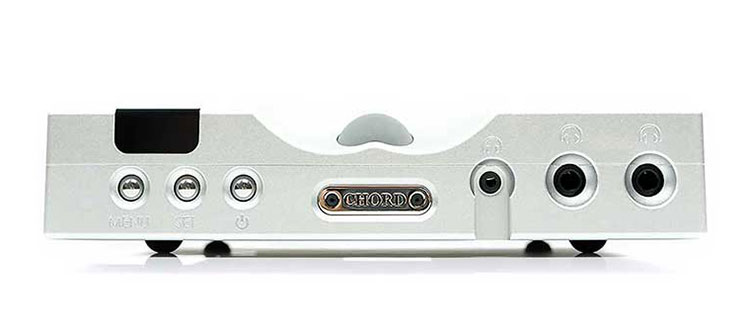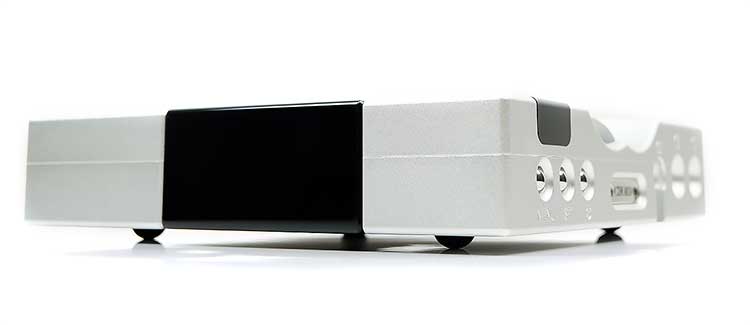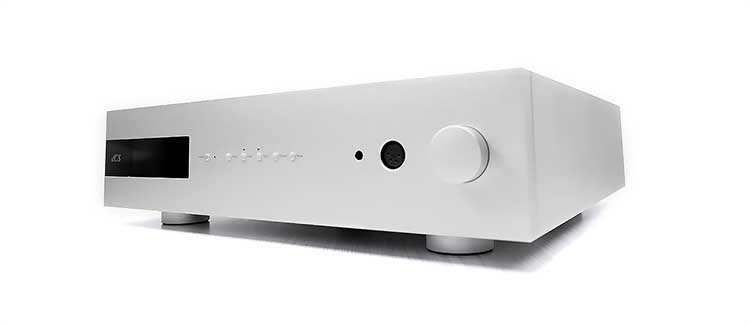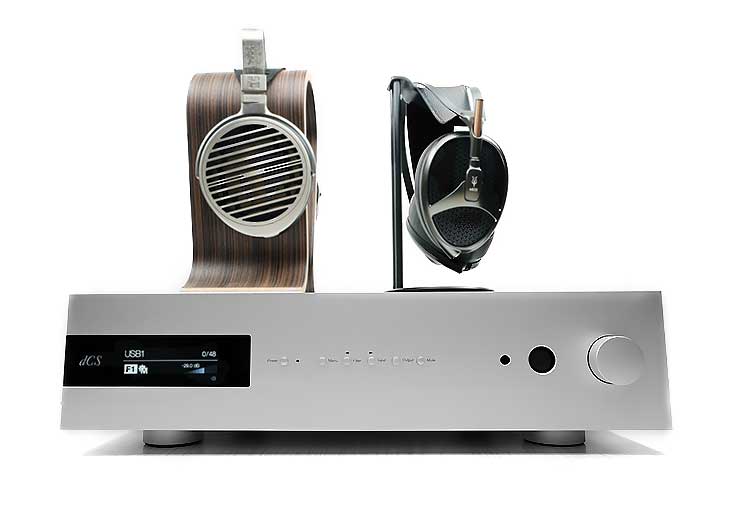Select Impressions
Violectric HPA V281
$2499.95
For this comparison, we used the lineout from the V590 into the V281 to get a comparison between the two amplification stages. The stock HPA V281 does not have a built-in DAC.
Volume Control
Just to note the V281 I am comparing with is not the FE or Final edition of this classic pure amplifier. I guess you could call it the normal edition with its stepped attenuator and lack of remote control.
There is no reed relay type volume control on the V281 here in the office either. Instead, it uses an Alps RK27 potentiometer which coincidentally is the same pot you will get on the normal version of the V590.
You get something like 41 physical steps as opposed to the upgraded relay version which had 128 steps at 0.75dB intervals. The reed relay on the V590 implementation is the same as the one they use inside the TOTL Niimbus US4+ and 256 ‘steps’ at a tighter 0.5dB interval between each one.
Amplification Shaping
The amplification output is also shaped quite differently on the V590. The V281 might still be the best mW performer for those 600Ω headphones with a 2.7W 40.2V output compared to 740mW and 21.1V from the V581.
However, its performance peaks at 100Ω loads at which point it drops in both mW and voltage output capacity compared to the V590 once you get to lower loads. At 32Ω, for example, the V281 is generating 2.8W and 9.5V compared to the V590’s gutsier 4W and 11.3V.
Peak performance for the V590 Class A/B amplifier is shaped more for the 50Ω to 32Ω load territory which is a better fit for modern planar headphones that are much lighter in terms of resistance loads but heavier on current demand.
On top of that you also get a wider pre-gain min and max with the V590 at ±18dB compared to ±12dB at both headphones out and lineout to the rear, a boon for Abyss and class Hifiman planars who need the ‘dial to go to 11’.
Noise
Numbers are not everything in terms of amplification though. The V590’s output is also a good deal quieter with up to 8dB less measured noise at -103dBu compared to the V281’s -95dBu A-weighted rating.
With headphones such as the Empyrean and the Susvara, you could pick up on a slightly blacker background with the V590 compared to the V281.
Combine that performance with a -18dB pre-gain reduction potential and viola, you can stick a set of Campfire Audio Solaris SEs in there and get plenty of useable volume and not a lot of hiss.
Compare that with the noisier V281 at zero volume with -12dB max pre-gain reduction and a higher dB per step volume control and it’s less sensitive IEM friendly with far more hiss.
Design
Both have that signature monolithic type industrial black rugged aluminum design typical of a Violectric product. However, the V281 has a very different narrow and long-form factor and is the lighter of the two despite both using that 25w x 2 toroidal transformer design side.
The reason behind this more traditional desktop form factor is likely to do with the physical space required for the additional resampling and DAC options to the front and the digital input options to the rear rather than any engineering reticence.
Performance
I have always considered the V281 to be the king of bass for my solid-state amplifiers. Comparing the coloration and bass quantity of the V281 to the V590 has not changed my opinion in that regard. It is still very powerful with solid warmth. However, is it as refined? Perhaps not quite.
The V590 does ease off on the low-end compared to the V281 coming off as comparatively neutral in quantity.
However, in doing so you get a better appreciation in terms of resolving complex layering, a tighter bass definition as well as leaving a bit more space for the mids to shine through when the low-end gets busy. The clarity simply goes up a level on the V590 as a result.
Another area that I kept noticing between these two was the superior upper-mids and treble refinement on the V590 compared to the V281. The V281 is not an overly bright amplifier in the scheme of things but sometimes its treble does not come off as the more refined sounding.
Using the Susvara and the Diana Phi as our test headphones higher-pitched notes sounded relatively smoother with better separation and without increasing any perceived attenuation on the V590.
It tends to impart some sweetness into the mids timbre that is not quite there with the V281, at least in the upper mids which can sound edgier and slightly thinner.
Chord Electronics Hugo TT2
£3995
DAC & Sampling
Like the V590 the Hugo TT2 is also a DAC, preamp, and headphone amplifier but there several big differences internally and externally between these two similar-priced systems. The Chord uses a proprietary DAC based on WTA or tap length design by Rob Watts.
Instead of a delta-sigma solution, the TT2 uses a custom-coded Xilinx Artix 7 FPGA with 86x 208MHz cores running in parallel to create an advanced 16FS WTA 1 filter with 98,304 taps. Typically pitched as outpacing delta-sigma taps that number in the hundred.
You could argue that the dual-AK4490EQ inside the V590 is no match for this on paper and in terms of decoding future-proofing, it isn’t with up to PCM 32BIT/768kHz decoding and DSD512 native decoding from the TT2 compared to native DSD256 and PCM 32BIT/384kHz for the V590.
Of course, that is not the final word because both have integrated amplification stages that do indeed color the sound differently.
The V590 also has built-in resampling for which the TT2 required the Hugo M Scaler combined to be able to offer resampling. Admittedly, the M Scaler resampling is excellent but the Chord combo comes at double the cost of the V590 alone.
A few other important differences surround the level of integration. The V590 is far more flexible with the ability to use just the headphone amp and connect to a 3rd party DAC via analog inputs.
The Hugo TT2, like the V590, will allow you to DAC out to an amp of your choice as a preamp but not DAC-in to use the TT2 headphone output alone. Instead, the TT2 modular scaling is on the digital side such as the use of dual BNC for M Scaler functionality.
Amplification
Both have excellent amplification outputs though, once again, different approaches. The V590 primarily operates in the Class A domain though pushes into a Class AB operation sub 50mA with both unbalanced and balanced topologies. It also offers a pre-amp output and a fixed lineout with a manual switch at the back able to control both.
The TT is also a preamp and headphone amplifier with balanced outputs for pre-amping but unbalanced only for headphone output. We also know it uses a discreet output stage between the DAC and filter and before the amplifier to reduce potential distortion.
The TT2 offers a wider range of unbalanced outputs at 3.5mm and two 6.35mm sockets whereas the V590 offers both balanced and unbalanced with 4-pin XLR and two 6.35mm sockets.
The TT2 offers a flexible voltage supply of 288 mW RMS into a 300Ω load right up to 2.7W into 32Ω on the high-end unbalanced. The V590 can deliver 740mW into a 600Ω load and peaks at 5.5W at 50Ω before dropping to 4W at 32Ω.
Noise
There isn’t a huge amount of correlative data to directly compare noise levels between the two system outputs but on paper, the dynamic range of these two systems outputs are excellent with the V590 rated at 132dB and the TT2 at 127dB, both A-weighted.
Bear in mind though this is optimal and not like for like as the TT2 is single-ended only whereas the V590 rating is balanced.
The TT2’s provision of a 3.5mm output jack is a hint though as this is a much quieter amp for sensitive IEMs like the Solaris. Not that the V590 is noisy but it does have a higher noise floor with Campfire Audio’s hiss detector Solaris.
Both run nice and quiet with 64 Audio’s 104 SPL tia Trio and the V590 closes the gap a little once you throw on the -18dB pre-gain switch.
Design
Vastly different design philosophies. The TT2 is much smaller and lighter compared to the V590 with a very modern minimalist aesthetic in either silver or black. The V590 is all black, chunky with switches and dials, and like a pleasurable albeit solid slice of a HiFi age long gone.
How you approach that design difference ultimately depends on how comfortable you are with Chord’s orb color control system which does require more of a learning curve.
You do not need to read the manual with the V590 so much, it seems more intuitive or at least more traditional in its operation. You do get a small postage stamp LCD with the TT2 which does help but once stacked it is a bit harder to read. Both have remote controls which also helps, at least for me.
Performance
Some definite differences between these two particularly in timbre and imaging. From a staging perspective, the TT2 is more forward and immediate through the mids whereas the V590 pushes back a little bit and sounds a bit more relaxed in its delivery.
It is like the difference between a studio and a live recording. The TT2 presentation on the Heddphones is vivid, the vocals are to the fore, the timbre is accurate, the pace is fast, and the articulation is crazy good. The perfect studio performance you could say.
The V590 pulls you back from the front row a little more, offering a bit more warmth in the process across the FR but also a slightly larger staging quality. I suspect there is a bit more weight on the low-end that acts as a factor in this perception because our test Heddphones can go incredibly deep on a good amplifier.
The instrumental timbre is a shade softer, more euphonic with a note decay that perhaps lingers a bit longer on the V590. Vocals have a more liquid tone but in terms of imaging, they sit further back as does the treble presence compared to the TT2.
It may well be that more neutral vocal positioning contributes to the perceived additional space or ambiance because of the way the TT2 pushes right up to you with its vivid presentation.
dCS Bartok
$17250
The dCS Bartok is a massive jump up in price but I thought it would be worth a comparison just to see where the value adds might be and specifically, the core DAC/Amplification performance as both are essentially integrated systems.
DAC
The Ring DAC is a discrete DAC that combines the proprietary FPGA control board with a DAC board using linking upgradeable software.
The main purpose of the control board is to reduce noise, properly noise shape the stream, and ensure the clocking is ultra-precise, i.e. do away with digital jitter before moving it to the digital audio conversion board.
The V590 is solidly in the delta-sigma camp with its dual-mono AKM AK4490EQ implementation and I think most would agree, at least on paper and on a pure DAC basis the Ring DAC is going to be the superior performing decoder.
However, in terms of decoding rates, the Bartok is not the end of the line like the TT2. In fact, at DSD128 and PCM 24BIT/384kHz, it comes off second best to the V590’s DSD256 native and PCM 32BIT/384kHz decoding potential.
Amplifier
Both have very similar operating modes with their amplifiers. Both the Bartok and V590 operate in Class A up to a certain point then switch to Class AB mode once current becomes a more important criterion, more so than outright voltage demands.
For the Bartok, its peak output mW rating is around 66Ω at 2.8W per channel dropping to around 600mW for 600Ω, and on the other side, 1.4W 32Ω load rating, (balanced). The V590 seems to offer stronger output shaping at 5.5W at 50Ω per channel and dropping to 2W at 32Ω per channel.
Both have adjustable gain which can be applied on a level basis, the Bartok digitally and the V590 manually.
The Bartok offers 4 levels of gain from -30dB to 0dB with a split of that attenuation between the DAC (10dB) and the amplifier (20dB). The V590 offers a wider swing of 36dB over a ±18 range, also over 4 levels, that can be applied to the lineout or the headphone out.
Noise
It is slightly tricky to draw some direct comparisons as some of the technical data that can be compared is 3rd party. dCS’s specs are a bit slim in terms of noise also.
However, from my own Bartok review, I mentioned a THD+N of 0.00025% which the V590 compares very favorably to at 0.00079 % when tested at @1kHz 1W. However, in terms of a pure noise floor hard number, the Bartok measures at -112dB which is lower than the V590’s -103dB rating and that shows with super sensitive gear.
In real-world terms, neither offers a pitch-black background with sensitive IEMs but the degree of control and amount of hiss depends also on their respective gain levels. At 0dB, the Bartok is too noisy and fairly quiet at -30dB gain with plenty of useable headroom for volume control.
The V590 is also too noisy on its default gain level and quieter at 18dB but relative to the Bartok still a bit too high for sensitive IEMs.
There is a slightly audible signal at 0 and a very slightly higher level of hiss on the lowest gain setting. That being said, you can work with them with IEMs as both play a lot better with gear rated with a lower SPL of around 105-110dB or less.
Design
The Bartok is just huge as in 47lb of huge. It makes the V590 almost seem like a featherweight. Both designs are super solid and robust with clean lines and hefty aluminum shells. The Bartok can come in black or silver whereas the V590, for now, is just in black.
The Bartok is more minimal in terms of front panel controls. Yes, you can operate everything from its few buttons and LCD panel-based menus but it is awkward and slow and not a patch on the instant access the V590 switch-based solution offers for manual options.
However, the dCS Mosaic app for the Bartok does have a lot of in-depth customization as well as integrated streaming services and that’s where the value of the Bartok’s features tends to shine through.
Features
Both do have resampling capability, but the Bartok is not as specific about levels and it is not pitched as a major feature. Instead, it pushes more for filter and crossfeed control on the digital side via its dCS Mosaic app.
With Ethernet capability, you can integrate the Bartok right into your modern home network and open it up to a lot of brilliant features wirelessly, something which the V590 lacks.
From there, you have a lot of additional controls such as USB class type, clock modes (modular instead of fixed inside the V590), crossfeed alteration, and Roon Ready integration.
However, like the TT2 the Bartok cannot take an analog input so its amplification stage is very much aligned to the DAC stage. You cannot bypass the dCS Bartok Ring DAC whereas you can bypass the DAC inside the V590 and use a 3rd party source.
Performance
In a roundabout way, both are aiming for common ground with their tuning. The two systems remain steadfastly ‘musical’ with warmth or a natural tone and detail that introduces a sense of realistic gritty rawness to instruments and vocals.
I originally defined the Bartok as rich and dense in my review a few months back and that remains true to this day. However, contextually, the V590 might not be quite as gritty and resolving in its timbre but it does sound the more weighted and powerful of the two signatures.
The V590 weight right at the low end, around 100Hz, and when tested with the Abyss Diana V2 is firmer. Whereas the Bartok aims a little more for balance through to the mids.
Both have a nice hue of warmth but comparatively speaking the V590 offers a bit more low-end bias whereas the Bartok teases out a bit more from the lower-mids of the Abyss.
The Bartok/Diana V2 mids also have a bit more refinement and sweetness in its timbre making it sound the more vivid and open of the two performances. The V590 pulls back just a shade in terms of positioning and body to create a smooth but more relaxed sound.
I did find the ‘Best” sampling of the V590 the most natural competitor to the Bartok stock sound and the one I would most likely stick with when comparing the two systems. The stock sound just came off as a little bit harder-edged in the mids and treble for my liking.
The two systems have a relatively relaxed treble delivery but I found the Bartok a bit less so. That does give it that sweeter timbre and more ‘bloom’ in higher-pitched imaging cues whereas the V590 wants you to pay attention more to its power lower-down.
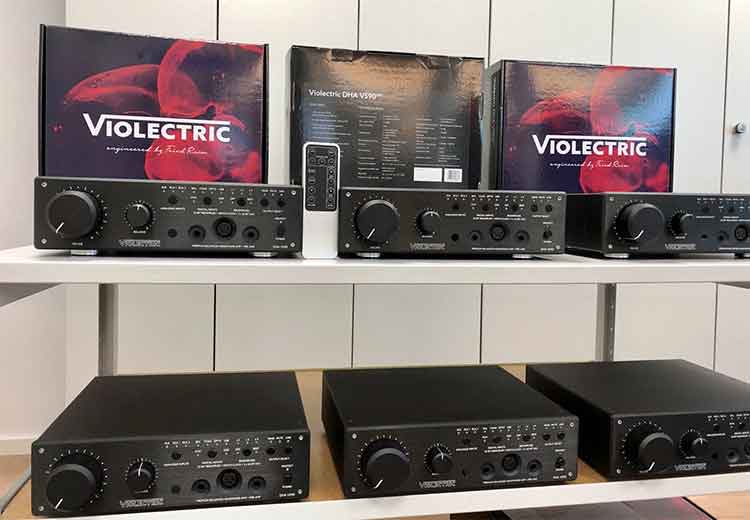
Our Verdict
The Violectric V590 is an absolute powerhouse of an amplifier and makes a mockery of those who might think the AK4490EQ is now told old to meet the demands of a modern audiophile.
This is a natural to slightly sweet-sounding yet powerful presentation with a nuanced resampling system that allows you to fine-tune out any harmonic oddities to an impressive level.
I think V281 fans will be impressed by the V590’s amplification performance without feeling that Violectric has strayed away from what made that amp so special for the last few years. It will drive just about any headphone with room to spare yet at the same time with the enhanced pre-gain system IEMs and sensitive headgear are a viable option.
Integrated systems are mightily popular this year with the dCS Bartok a world-class example of modern audio engineering. This is another one worth recommending and for a lot less money than the Bartok also!
Violectric DHA V590 Specifications
- All Data RMS unwtd., 20 Hz – 20 kHz, Pre-Gain set to 0 dB
- Analog input parameter
- Inputs (stereo): 1 x XLR female, balanced, 2 x RCA, unbalanced
- Max. input voltage: + 21 dBu, Input impedance: 10 kohm
- Digital input parameter
- Digital PCM inputs: 1 x balanced, 1 x coaxial, 1 x optical, up to 24 bit, 192 kHz
- Digital USB input: PCM up to 32 bit, 384 kHz, DSD 64 – 256
- Resampling/reclocking: 32-bit, up to 180 dB dynamic range
- D/A converters: 32 bit dual-mono, -112 dB THD+N, 120 dB dynamic range
Line out parameter
- Line outputs (stereo, analog): 1 x XLR male, balanced, 1 x RCA unbalanced
- Line-Out Gain: -18 / -12 / -6 / 0 / +6 / +12 / +18 dBr
- Max. output voltage: + 21 dBu, Output impedance : 1 Ohm
Headphone amp parameter
- Nominal input sensitivity: +6 dBu
- Feedback gain: 0 dB unbal / +6 dB bal
- PRE-GAIN: -18 / -12 / -6 / 0 / +6 / +12 / +18 dBr
- Frequency range: 5 Hz – 250 kHz (- 0.5 dB)
- Balance: +/- 6 dB
- Output impedance: 0.15Ω unbalanced/0.3Ω balanced
- Damping factor (Load 50Ω): 320 unbalanced/160 balanced
- Dynamic range: > 131 dB (A-wtd)
- Noise: < -103 dBu (A-wtd)
- THD+N (1kHz/2x10V/100R = 1W) : < -102 dB / < 0.0008 %
- THD+N (1kHz/2x4V/32R = 0.5W) : < -100 dB / < 0.001 %
- Crosstalk: -105 dB (1 kHz) / -100 dB (15 kHz)
- Headphone outputs: 1 x 4-pin XLR, 2 x 1⁄4“ (6.3 mm) jack



